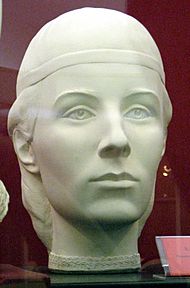Elena Glinskaya facts for kids
Quick facts for kids Elena Glinskaya |
|
|---|---|
 |
|
| Grand Princess consort of Moscow | |
| Tenure | 1526–1538 |
| Born | c. 1510 |
| Died | 4 April 1538 (age 27–28) |
| Burial | Ascension Convent, Kolomenskoye Archangel Cathedral, Kremlin |
| Spouse | Vasili III of Russia |
| Issue | Ivan Vasilyevich Yuri Vasilevich |
| House | House of Glinski House of Rurik (by marriage) |
| Father | Vasili Lvovich Glinsky |
| Mother | Ana Jakšić |
| Religion | Eastern Orthodox |
Elena Vasilyevna Glinskaya (Russian: Елена Васильевна Глинская; c. 1510 – 4 April 1538) was an important figure in Russia's history. She was the second wife of Grand Prince Vasili III. This made her the Grand Princess consort of Russia.
After her husband's death, Elena became the ruler of Russia for five years. This period lasted from 1533 until her own death in 1538. She was also the mother of the famous Tsar Ivan the Terrible.
Grand Princess
Her Marriage
Elena was born around 1510. Her father was Prince Vasili Lvovich Glinsky. Her family was from a group called Lipka Tatars. They believed they were related to the Mongol ruler Mamai. Her mother was a Serbian Princess named Ana Jakšić. Elena's powerful uncle, Prince Mikhail Lvovich Glinsky, helped her family become well-known.
In 1525, Grand Prince Vasili III decided to divorce his first wife, Solomoniya Saburova. She could not have children. He then chose to marry Elena. Records from that time say he picked Elena because she was "beautiful and young." Even though some people in the Russian Orthodox Church disagreed, the divorce happened. Elena and Vasili III were married on January 21, 1526.
Elena gave birth to two sons. The first was Ivan Vasilyevich in 1530, who later became Ivan IV the Terrible. Her second son, Yuri Vasilievich, was born in 1532. He later became Prince Yuri of Uglich. Some stories from that time said that Elena brought people from Finland and the Sami to help her have children using magic.
Her Time as Regent
When Vasili III was dying, he gave his power to Elena. Their oldest son, Ivan, was only three years old. Elena was to rule until Ivan was old enough to take over. The old records don't say exactly what her official title was. But everyone knew she was in charge, and the important nobles, called boyars, had to report to her. This is why the years from Vasili's death in 1533 to Elena's death in 1538 are known as the "Reign of Elena."
Elena faced challenges from her husband's brothers, Yury Ivanovich and Andrey of Staritsa. She managed to deal with these challenges. Both brothers were later put in prison, in 1534 and 1537.
Elena was a very skilled leader. In 1535, she made an important change to the country's money. She created a single monetary system for all of Russia. This made trade and business easier. In foreign affairs, she was also successful. She signed a peace agreement with Lithuania in 1536. At the same time, she made sure Sweden did not pose a threat to Russia.
She also ordered a new defensive wall to be built around Moscow. Elena invited new people to settle in Russia from Lithuania. She also helped buy freedom for Russian prisoners. She put in place rules to protect travelers from bandits on the roads. Elena was also known for visiting several convents, which are religious communities. However, her time as ruler also saw some disagreements within the government. These were caused by her close advisors, including a young noble named Ivan Feodorovich Ovchina-Telepnev-Obolensky.
Elena died in 1538 when she was still quite young. Her son's governess, Agrippina Fedorovna Chelyadnina, was arrested after Elena's death. Some historians believe that Elena was poisoned by the Shuisky family, who took power after she died. Recent studies of her remains seem to support the idea that she was poisoned.
Images for kids
See also
In Spanish: Elena Vasílievna Glínskaya para niños



